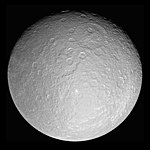List of geological features on Rhea
Appearance
(Redirected from List of craters on Rhea)
This is a list of named geological features on Rhea, the second largest moon of Saturn.[1] Planetary features are approved by the International Astronomical Union's (IAU) Working Group for Planetary System Nomenclature (WGPSN).[2]
Catenae
[edit]A catena /kəˈtiːnə/ is a crater chain.
| Name | Coordinates | Diameter (km) | Approval Date | Named After | Notes | Ref |
|---|---|---|---|---|---|---|
| Koykamou Catena | 70°S 244°W / 70°S 244°W | 110 | 6 August 2010 | Koykamou, a mountain in Nganasan mythology | — | WGPSN |
| Mouru Catena | 48°30′N 343°30′W / 48.5°N 343.5°W | 80 | 6 August 2010 | Merv, holy land in Persian mythology | — | WGPSN |
| Onokoro Catenae | 44°42′S 328°30′W / 44.7°S 328.5°W | 240 | 6 August 2010 | Onokoro, mythical island in Japanese mythology | — | WGPSN |
| Puchou Catenae | 32°N 87°W / 32°N 87°W | 620 | 6 August 2010 | Pu Chou Mountain in Chinese mythology | Formerly classified as a chasma | WGPSN |
| Thebeksan Catena | 39°30′S 174°00′W / 39.5°S 174°W | 220 | 6 August 2010 | Thebeksan, holy mountain in Korean mythology | — | WGPSN |
| Wungaran Catenae | 22°30′N 79°00′W / 22.5°N 79°W | 350 | 6 August 2010 | Wungaran, sacred place in Kakadu, Australia | — | WGPSN |
Chasmata
[edit]Rhean chasms are called chasmata. They are named after sacred places in world mythologies.
| Chasma | Named after |
|---|---|
| Avaiki Chasmata | Avaiki, the underworld in Cook Islands mythology |
| Galunlati Chasmata | ᎦᎸᎳᏗ galvladi (galvv́ládii) "the above": the land above the sky in Cherokee mythology |
| Kun Lun Chasma was reclassified as a linea in 2010 (see below) | |
| Pu Chou Chasma was reclassified as a catena in 2010 (see above) | |
| Pulag Chasma | Pulag, sacred mountain in Igorot mythology |
| Vaupas Chasma | Vaupas, a river in the mythology of the Cuebo of Colombia |
| Yamsi Chasmata | Yamsi, lodge of the North Wind in Klamath mythology |
Craters
[edit]Rhean craters are named after figures from the mythologies of mostly non-European cultures. As of 2017, there are 128 named craters.[3]
Fossae
[edit]A fossa is a long, narrow depression.
| Name | Coordinates | Diameter (km) | Approval Date | Named After | Ref |
|---|---|---|---|---|---|
| Harahvaiti Fossa | 36°S 171°W / 36°S 171°W | 190 | 6 August 2010 | Beautiful land created by Persian god Ahura Mazda; modern Kandahar, Afghanistan | WGPSN |
| Parun Fossa | 46°30′S 152°00′W / 46.5°S 152°W | 120 | 6 August 2010 | Parun River, Nuristan (NE Afghanistan), in which the mother goddess Disani gave birth to Bagisht, the creator of people | WGPSN |
Lineae
[edit]A linea is a long marking on a planet or moon's surface.
| Name | Coordinates | Diameter (km) | Approval Date | Named After | Notes | Ref |
|---|---|---|---|---|---|---|
| Kirinyaga Linea | 1°48′S 128°48′W / 1.8°S 128.8°W | 400 | 17 June 2010 | Mount Kenya (Kirinyaga), a holy mountain in Kikuyu mythology. | — | WGPSN |
| Kunlun Linea | 45°N 308°W / 45°N 308°W | 180 | 6 August 2010 | Kunlun Mountains, home of the gods in Chinese mythology | Formerly classified as a chasma | WGPSN |
See also
[edit]Wikimedia Commons has media related to Maps of Rhea.
References
[edit]- ^ "IAU – Gazetteer of Planetary Nomenclature – Rhea". US Geological Survey. Retrieved 14 August 2017.
- ^ "Categories for Naming Features on Planets and Satellites". US Geological Survey. Gazetteer of Planetary Nomenclature – International Astronomical Union (IAU) Working Group for Planetary System Nomenclature (WGPSN). Retrieved 14 August 2017.
- ^ "Nomenclature Search Results: Rhea > Crater, Craters". US Geological Survey. Gazetteer of Planetary Nomenclature – International Astronomical Union (IAU) Working Group for Planetary System Nomenclature (WGPSN). Retrieved 14 August 2017.

